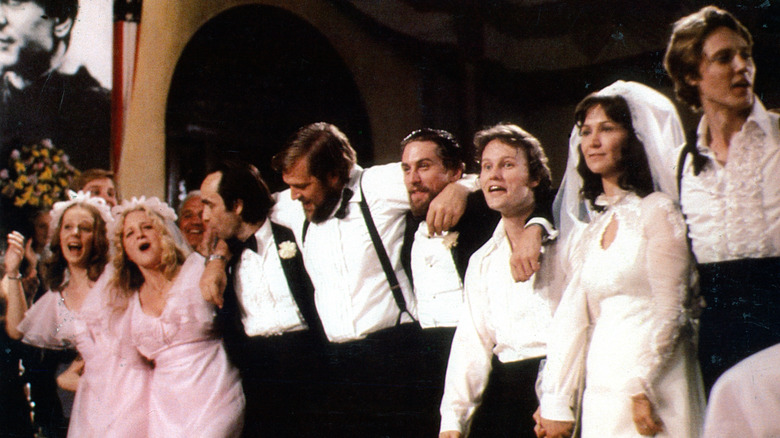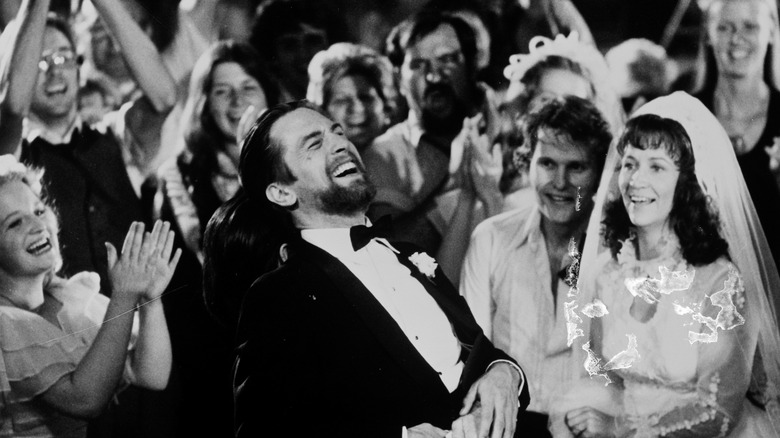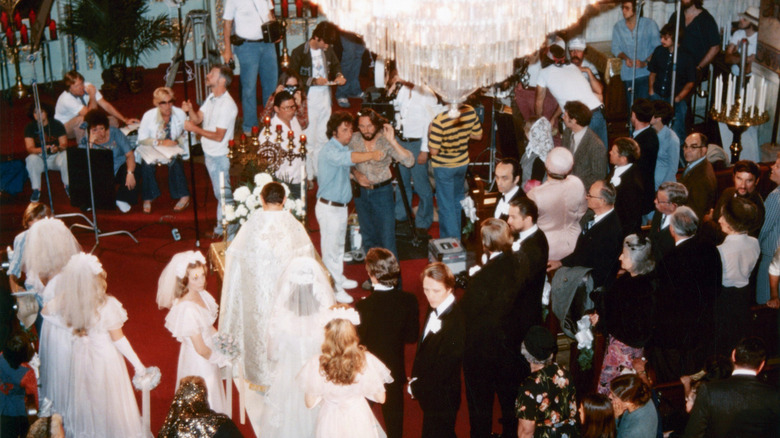The Deer Hunter's Wedding Scene Caused Robert DeNiro To Collapse On Set
Of all the directors in the 1970s, a decade of American filmmaking rife with examples of maverick auteurs exceeding their authority, Michael Cimino might surpass even Stanley Kubrick as the most indulgent. Cimino only made two films that were released during the '70s, and their productions could not have been more different. 1974's "Thunderbolt and Lightfoot," Cimino's debut feature, starred Clint Eastwood, a man who refused to do more than a couple takes of any given scene no matter what. On the "Thunderbolt" set, Eastwood was a producer as well as star, and kept Cimino reined in.
That would be far from the case on Cimino's next feature, 1978's "The Deer Hunter," a movie that would prove to be the director's masterpiece of both artistic value and justified indulgent length. Cimino's film about the psychological and social effects of the Vietnam War on blue-collar Americans sought to encapsulate as full an experience of its ensemble of characters as possible, leading the director to demand an enormous number of takes for just about every scene.
If "The Deer Hunter's" most notorious scenes are of its POW soldiers being forced to play Russian roulette with loaded guns by the North Vietnamese Army, its most controversial may ironically be the far friendlier and non-violent opening act of the film: the wedding of Steven (John Savage) and Angela (Rutanya Alda) in the steel town of Clairton, Pennsylvania. Looking to capture the extreme edges of reality for what he intended to be a challenging and gritty film, Cimino pushed his cast and crew to the breaking point on these scenes, leading to star Robert DeNiro and others to collapse on set — and on camera.
The never-ending wedding
Most weddings occur over a few hours, but "The Deer Hunter's" wedding lasted for five long days. While the filming of the movie's Clairton scenes took place over four states, the wedding portions were shot at the St. Theodosius Russian Orthodox Cathedral in Cleveland, Ohio. Cimino and his producers sought to create a lively, vibrant, and, above all, authentic environment for the scenes, as extras partying it up in the reception filmed at the nearby Lemko Hall drank liquor and beer for real.
This approach likely suited star De Niro, as by the late '70s the emerging screen legend had gained a reputation for Method-style research and intense commitment to character. Cimino was only too happy to indulge his leading actor's predilections, going so far as to give De Niro a wallet with a driver's license in it that had his character's name on it. The entire cast including De Niro spent a week together hanging out before the movie began, and star Christopher Walken remembered that they "went to a real Russian wedding, huge, with food and dancing" for research.
Yet all of that couldn't fully prepare the cast and crew for the marathon of the actual shoot, with the wedding sequence being shot in the middle of principal photography. The film had already gone over budget by that point, and Cimino was prodded by his producers to hurry up with a sequence that showed every sign of being lengthy, in production as well as in the eventual movie itself. Cimino placated such advice and then went ahead and shot the way he wanted to shoot anyhow, searching for the unique quality he intended for the opening act of the movie. As cinematographer Vilmos Zsigmond recalled, "Michael didn't know what he was looking for, but he knew he was looking for something special."
In a sequence that ends up containing a number of special moments, one incident stands out: a bit where Stanley (John Cazale) exuberantly picks up a reticent but grinning Michael (De Niro) in order to bring him to the dance floor. Upon their arrival, the two men collapse onto the ground, a real-life accident that speaks to the authentic atmosphere Cimino was trying to capture. As Zsigmond explains, "they were so tired. That was obviously an accident, but that's what [Cimino] was looking for."
'The heart of the film' almost doesn't make the final cut
Producer Barry Spikings was so impressed with "The Deer Hunter's" wedding scenes that he referred to them as "the heart of the film." However, the higher-ups at Universal Studios weren't of the same opinion. When Cimino's cut of the movie came in at just over three hours long, the executives found the movie not only objectionable in its content but "endless," as Universal president Thom Mount described it, mentioning the wedding sequence in particular as "a cinematic event all unto its own."
Universal took the movie into their own hands at that point, and Mount handed the footage to the studio's head of postproduction, Verna Fields. Fields "started to turn the heat up on Michael," says Mount, cutting about 20 minutes from the wedding sequence. Both Universal's shorter cut and Cimino's director's cut were previewed to select audiences, with varying accounts of the responses to those screenings. The deciding factor was the C.E.O. of EMI (the record company who produced the movie as one of their first ventures into filmmaking), Bernard Delfont, being given the choice of which cut to release: he chose Cimino's cut.
Thus, the full-length wedding sequence remained a part of the film, to "The Deer Hunter's" lasting benefit. It's a lyrical, engaging, and essential series of scenes that perfectly establishes the dynamic between the movie's ensemble of characters, showing their daily lives before everything changes as a result of their experiences in the war. It also acts as a companion piece to a film with another famous opening scene of a wedding, "The Godfather," with both films contrasting the exuberance of such a milestone event with tragedy that will soon follow. Moreover, the wedding scenes in "The Deer Hunter" portray a tangible sense of reality that Cimino was able to capture, with De Niro and Cazale's collapse on set as the most authentic — and most enduring — example.


